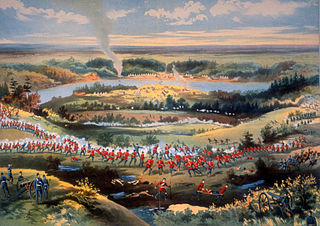
The North-West Rebellion, also known as the North-West Resistance, was an armed resistance movement by the Métis under Louis Riel and an associated uprising by Cree and Assiniboine of the District of Saskatchewan, North-West Territories, against the Canadian government. Many Métis felt that Canada was not protecting their rights, their land, and their survival as a distinct people. Fighting broke out in late March, and the conflict ended in June. About 91 people were killed in the fighting that occurred that spring before the conflict ended with the capture of Batoche in May 1885.
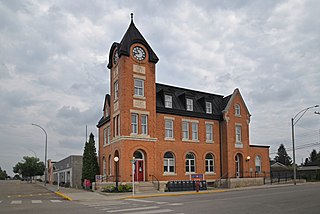
Battleford is a town located across the North Saskatchewan River from the City of North Battleford, in Saskatchewan, Canada.

The Battle of Cut Knife, fought on May 2, 1885, occurred when a flying column of mounted police, militia, and Canadian army regular army units attacked a Cree and Assiniboine teepee settlement near Battleford, Saskatchewan. First Nations fighters forced the Canadian forces to retreat, with losses on both sides.
The Battle of Frenchman's Butte, fought on May 28, 1885, occurred when a force of Cree, dug in on a hillside near Frenchman's Butte, was unsuccessfully attacked by the Alberta Field Force. It was fought in what was then the District of Saskatchewan of the North-West Territories.

The Battle of Duck Lake was an infantry skirmish 2.5 kilometres (1.6 mi) outside Duck Lake, Saskatchewan, between North-West Mounted Police forces of the Government of Canada, and the Métis militia of Louis Riel's newly established Provisional Government of Saskatchewan. The skirmish lasted approximately 30 minutes, after which Superintendent Leif Newry Fitzroy Crozier of the NWMP, his forces having endured fierce fire with twelve killed and eleven wounded, called for a general retreat. The battle is considered the initial engagement of the North-West Rebellion. Although Louis Riel proved to be victorious at Duck Lake, the general agreement among historians is that the battle was strategically a disappointment to his cause.

The Battle of Fish Creek, fought April 24, 1885 at Fish Creek, Saskatchewan, was a major Métis victory over the Canadian forces attempting to quell Louis Riel's North-West Rebellion. Although the reversal was not decisive enough to alter the ultimate outcome of the conflict, it was convincing enough to persuade Major General Frederick Middleton to temporarily halt his advance on Batoche, where the Métis would later make their final stand.

Leif Newry Fitzroy Crozier, commonly known as L. N. F. Crozier, was a Canadian Militia officer and a superintendent of the North-West Mounted Police (NWMP), now best remembered for his role in the North-West Rebellion of 1885, a resistance movement headed by Métis leader Louis Riel in what is now the modern province of Saskatchewan.
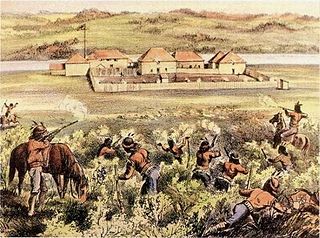
The Battle of Fort Pitt was part of a Cree uprising coinciding with the Métis revolt that started the North-West Rebellion in 1885. Cree warriors began attacking Canadian settlements on April 2. On April 15, they captured Fort Pitt from a detachment of North-West Mounted Police.
The Battle of Loon Lake, also known as the Battle of Steele Narrows, concluded the North-West Rebellion on June 3, 1885, and was the last battle fought on Canadian soil. It was fought in what was then the District of Saskatchewan of the North-West Territories, at what is now known as Steele Narrows at Makwa Lake, in Saskatchewan's Steele Narrows Provincial Park. Steele Narrows is a channel that separates Sanderson Bay from Makwa Lake.
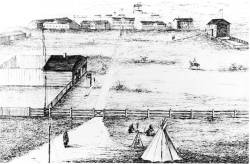
Fort Livingstone was founded as an outpost in North-West Territories, Canada. The outpost briefly served as the capital city for the North-West Territories government for the years of 1874 to 1876 until it moved to Battleford, Saskatchewan, and headquarters for the North-West Mounted Police for the same period, until they moved their headquarters to Fort Macleod, Alberta.

The Frog Lake Massacre was part of the Cree uprising during the North-West Rebellion in western Canada. Led by Wandering Spirit, Cree men attacked and killed nine officials, clergy and settlers in the small settlement of Frog Lake, at the time in the District of Saskatchewan in the North-West Territories on 2 April 1885.

Fort Pitt Provincial Park is a provincial park in the Canadian province of Saskatchewan. Fort Pitt was built in 1829 by the Hudson's Bay Company (HBC) and was a trading post on the North Saskatchewan River in Rupert's Land. It was built at the direction of Chief Factor John Rowand, previously of Fort Edmonton, to trade for bison hides, meat and pemmican. Pemmican, dried buffalo meat, was required as provisions for HBC's northern trading posts.
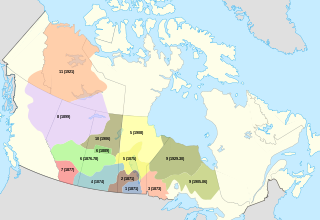
Wandering Spirit was a war chief of a band of Plains Cree. There is little information on Wandering Spirit's life. Most of what is known begins shortly before the 1885 Frog Lake Massacre and ends with the Canadian justice system's convicting him of murder and hanging him. However, there is some information regarding his role within the Plains Cree people.

The Provisional Government of Saskatchewan was an independent state declared during the North-West Rebellion of 1885 in the District of Saskatchewan of the North-West Territories. It included parts of the present-day Canadian provinces of Alberta, Saskatchewan, and Manitoba. The name was given by Louis Riel. Although Riel initially hoped to rally the Countryborn, Cree, and European settlers of the Saskatchewan Valley to his banner, this did not occur. The government, with the exception of Honoré Jaxon and Chief White Cap, had an entirely French-speaking and Métis leadership. Gabriel Dumont was proclaimed adjutant general in which capacity he became supreme military commander, although Riel could, and did, override his tactical decisions. The Provisional Government was declared by Riel on March 19, 1885. It ceased to exist following the defeat of the Métis militarily during the Battle of Batoche, which concluded on May 20, 1885. During its existence the government only exercised authority over the Southbranch Settlements along the South Saskatchewan River. Other major centres in the area such as Prince Albert, Saskatoon, and most First Nations reserves remained outside of its control.

Duck Lake is a town in the boreal forest of central Saskatchewan, Canada. Its location is 88 km (55 mi) north of Saskatoon and 44 kilometres (27 mi) south of Prince Albert on Highway 11, in the Rural Municipality of Duck Lake No. 463. Immediately to the north of Duck Lake is the south block of the Nisbet Provincial Forest.

Francis Jeffrey Dickens was the third son and fifth child of Victorian English novelist Charles Dickens and his wife Catherine Dickens née Hogarth.

The Looting of Battleford began at the end of March, 1885, during the North-West Rebellion, in the town of Battleford, Saskatchewan, then a part of the Northwest Territories.
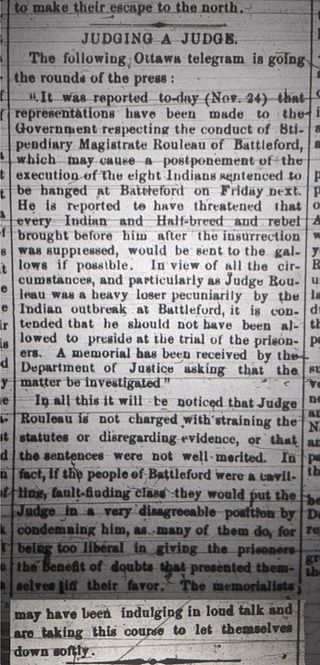
The hangings at Battleford refers to the hanging on November 27, 1885, of eight Indigenous men for murders committed in the North-West Rebellion. The executed men were found guilty of murder in the Frog Lake Massacre and in the Looting of Battleford. These murders took place outside the military combat that took place during the North-West Rebellion.

The North-West Mounted Police (NWMP) played a significant role during the North-West Rebellion in Canada in 1885. The NWMP suffered early reverses and, although they supported the relief force sent to the region under the command of Major-General Frederick Middleton, their performance was heavily criticized. Commissioner Acheson Irvine resigned from his command of the police as a result.
The 300-kilometre (190 mi) Swift Current–Battleford Trail was an important late-19th century transportation and communications link between settlements of Swift Current and Battleford – the result of a brisk trade, in buffalo bones which resulted heavy traffic between the two regions. Because of the large volume of Red River cart traffic, the ruts created during this period are still visible. The historical significance of this resulted in The Battleford Trail becoming a provincial heritage site in 1982.

















